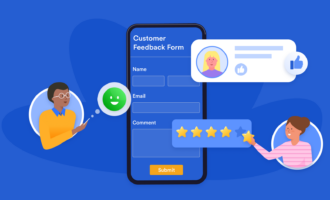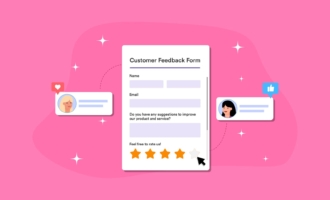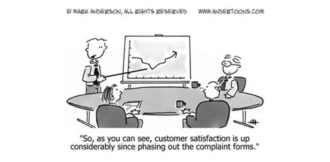Every business activity has a goal. Running a social marketing campaign? The goal is high engagement. Launching a new product? The goal is hitting the sales target. Requesting customer feedback? The goal is getting feedback that leads to meaningful change.
Customer feedback is a double-edged sword. If it’s old, inaccurate, or ambiguous, it can do more harm than good. Unclear and poor-quality feedback can leave business owners even less sure about what customers are thinking and what needs to be done to improve a product or service.
That’s why it’s so important to start the customer feedback process on the right foot. Here are five ways to get customer feedback that isn’t just good but great.
Enhance your customer feedback process with AI. Discover how Jotform’s AI Form Generator can streamline your workflow.
1. Ask the right questions
Feedback forms and questionnaires don’t need to be sophisticated or very detailed to glean insights that can make a difference. That’s why some of the most popular feedback methods, such as the Net Promoter Score® (NPS®) and the Customer Satisfaction Score (CSAT), are based on very simple questions like “How satisfied were you with the product?”
Customers are more likely to complete a feedback survey if it doesn’t appear too time-consuming. The key to high-quality feedback is asking focused questions that will uncover the insights you’re looking for.
2. Watch and listen carefully
There are other ways to get customer feedback besides requesting it. Unsolicited feedback, also known as “given feedback,” is provided by customers without any prompting from the company. You can find it in online forums, social media comments and posts, and reviews on third-party sites, such as Yelp and Amazon.
Given feedback is valuable because it is unedited. It’s not provided because the business asked for it. The customer doesn’t know whether the company will even see the feedback. Also, many customers will be less shy about saying what they think when they aren’t speaking directly to a customer service representative.
Businesses should continually monitor online mentions and discussions of their products and services. They can do this with the help of software, such as Mention.com or Social Mention, that frequently scans the web for the company name and other relevant terms, and sends alerts when mentions are identified.
Feedback of this nature is valuable because it provides a current picture of customer sentiment. Software can find and analyze online comments and mentions within hours of posting, so the feedback is fresh and immediate.
3. Get live feedback wherever possible
Feedback received in the heat of the moment will inevitably be raw and honest. The ride-sharing service Uber, for example, uses a real-time rating system that allows drivers and riders to leave feedback via the app, even during the ride.
When feedback is received in real time or close to it, you know that it’s fresh and unadulterated by tricks of memory or ruminations that can alter the impression of the experience after the passage of time.
Another advantage of live feedback is that it often takes the form of an actual conversation, such as a phone call or live chat. This is an opportunity for the service representative to steer the conversation and get more detailed insights. Either way, live feedback adds a rich layer of fresh critique that can be quickly shared with relevant employees and translated to actionable insights much faster.
Businesses can get live feedback from face-to-face, in-store conversations with customers, questions asked at the end of a service phone call, or a quick poll at the end of a live chat session.
Feedback that is nearly live is also valuable, such as a customer satisfaction poll sent via SMS or an email immediately following an interaction. For example, a short popup survey could ask customers about their checkout experience after they purchase a product online. The results can help address problems of cart abandonment or provide details about how to improve the overall checkout process.
4. Always follow up
Feedback is much more than customers answering your questions. Customer feedback is an ongoing dialogue between a business and its customers, and is often thought of as a “loop.”
Good customer feedback practice commonly follows the ACAF model — ask, categorize, act, follow up. Businesses ask customers for feedback, and once they receive it, categorize it into relevant chunks so they can deal with it properly and efficiently. The business acts on the feedback, making necessary improvements.
The final, and no less important stage, is follow-up. Businesses must respond to customer feedback and let customers know they received it, appreciated it, heard it, and — where relevant — that it led to real change.
Following up on feedback is important because it builds trust. When customers know their feedback was genuinely appreciated, they feel better about their experience and are more likely to return or recommend the company to others.
Follow-up is critical for both positive and negative feedback. Responding to positive feedback strengthens the customer’s existing good feeling. Handling negative feedback makes customers feel that you take them seriously and work hard to rectify their complaints. Ignoring negative feedback just doesn’t pay. Case in point: Two-thirds of customer churn can be prevented if a company fixes a problem the first time it happens.
5. Organize and assign feedback properly
No matter how accurate or focused feedback is, if a business doesn’t do anything with it, the feedback will be meaningless.
Businesses with solid customer feedback channels can quickly find themselves swimming in a pool of comments, star ratings, chat recordings, and survey responses. It’s crucial to have a system in place to organize the feedback so that you can properly analyze, understand, and act on it.
That’s where a platform like Jotform can be a lifesaver. The Jotform Form Builder provides hundreds of digital form, survey, and questionnaire templates you can customize for customer feedback. Since the entire process of sending, completing, and returning feedback forms happens online, it’s much easier for businesses to ask for feedback and for customers to provide it.
The feedback responses automatically populate Jotform Tables, where you can analyze, categorize, and assign it to relevant teams and staff members for action and the all-important follow-up.
Don’t settle for less
When it comes to customer feedback, quality is key. It doesn’t matter if a business collects thousands of responses; if the feedback is vague, irrelevant, or outdated, then it’s worthless.
The question isn’t how to get customer feedback, but rather how to get good customer feedback. Use the tips outlined above to make sure the customer feedback you receive is more than worth the time and effort you invest in gathering it. Then, it can truly lead the business in the right direction.
Net Promoter®, NPS®, NPS Prism®, and the NPS-related emoticons are registered trademarks of Bain & Company, Inc., NICE Systems, Inc., and Fred Reichheld. Net Promoter ScoreSM and Net Promoter SystemSM are service marks of Bain & Company, Inc., NICE Systems, Inc., and Fred Reichheld.












































































Send Comment:
1 Comments:
More than a year ago
Amazing Blog.
on demand app solutions